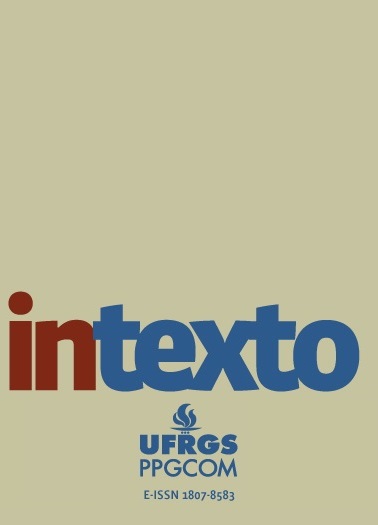The relationship of media language with the theory of judicial decision
DOI:
https://doi.org/10.19132/1807-8583202152.80322Keywords:
Mass Media. Media. Decision theory. Perlocutionary language.Abstract
It is observed that the research of the influence of the mass media in the theory of decision cannot be sustained only in pragmatic or field research aspects. There is a need for a more accurate analysis in relation to the importance of language in this relationship between the mass media and the theory of opinion. As an unconditional assumption of a transparent and consistent study of this influence, it is necessary to move through the conception of language, as well as to inquire about its effective importance in the relationship between the mass media and the theory of decision. For this, the analytical-critical methodology is used, and especially as regards the strength of the perlocutionary level of the media language. In the end, we intend to demonstrate the effective existence of this community of decision theory.
Downloads
References
ALTHEIDE, David. L. I mass media, il crimine e il 'discorso di paura'. In: FORTI, Gabrio; BERTOLINO, Marta(org). La televisione del criminine. Milano: V&P Università, 2005.
BARATTA, Alessandro. Problemi sociali e percezione della criminalità. Dei delitti e delle pene. Rivista di Studi Sociali, Storici e Giuridici Sulla Questione Criminale, Roma, ano I, n. 1, genn. - apr., 1983.
BEUCHOT, Mauricio. História de la filosofia del lenguaje. México: Fondo de Cultura Económica, 2005.
COROMINAS ESCUDÉ, Jordi. Ética primera:Aportación de X. Zubiri al debate ético contemporáneo. Bilbao: Desclée de Brouwer, 2000.
DEFLEUR, Melvin L.; BALL-ROKEACH, Sandra J. Teorie delle comunicazioni di massa. Bologna: Il Mulino, 1995.
HABERMAS, Jürgen. Consciência moral e agir comunicativo. Rio de Janeiro: Tempo Brasileiro, 2003.
KOSELLECK, Reinhart. Estructuras de repecticón en el lenguaje y en la historia. Revista de Estudios Políticos, Madrid, n. 134, dic. 2006.
KURY, Helmut. Mass media e criminalità: l’esperienza tedesca. In: FORTI, Gabrio; BERTOLINO, Marta (org). La televisione del crimine. Milano: V&P Università, 2005.
LÓPEZ ORTEGA, Juan J. Información y justicia. In: Justicia y medios de comunicación
. Madrid: Consejo General del Poder Judicial, 2006. (Colección Cuadernos de Derecho Judicial. Justicias y Medios de Comunicación).
MERLEAU-PONTY, Maurice. Merleau-Ponty na Sorbonne: resumo de cursos. Campinas: Papirus, 1990.
MUÑOZ, Blanca. Cultura y comunicación: – Introducción a las teorías contemporáneas. Barcelona: Barcanova, 1989.
NEVES, Antonio Castanheira. O actual problema metodológico da interpretação jurídica. Coimbra: Coimbra Editora, 2003.
PROSS, Harry. Estructura simbólica del poder: – Teoría y práctica de la comunicación pública. Barcelona: Gustavo Gili, 1980.
RICOUER, Paul. Interpretação e ideologias. Rio de Janeiro: Francisco Alves, 1977.
RICOUER, PAUL. O conflito das interpretações: – Ensaios de hermenêutica. Rio de Janeiro: Imago, 1969.
ROCHA, Leonel Severo. A problemática jurídica: uma introdução transdisciplinar. Porto Alegre: Fabris, 1985.
SILVERSTONE, Roger. Perché studiare i media? Bologna: Il Mulino, 2002.
SMAUS, Di Gerlinda. L’immagine della criminalità nei mass media contenuti e significati simbolici. La Questione Criminale – Rivista di Ricerca e Dibattio su Devianza e Controllo Sociale, Bologna, ano IV, n. 1, genn.-apr. 1978.
SORLIN, Pierre. Mass media. Londres: Celta, 1997.
TARUFFO, Michele. La motivazione della sentenza civile. Padova: Cedam, 1975.
VIVES ANTÓN, Tomás S. Más allá de toda duda razonable. Teoria y Derecho – Revista de Pensamento Jurídico, Valencia,. n. 2,jun.-dic. 2007.
WARAT, Luis Alberto. O direito e sua linguagem. Porto Alegre: Fabris, 1995.
Downloads
Published
How to Cite
Issue
Section
License
Copyright (c) 2021 Intexto

This work is licensed under a Creative Commons Attribution-NonCommercial 4.0 International License.
The copyright of works published in this journal belong to the authors, and the right of first publication is conceded to the journal. Due to the journal being of open access, the articles are of free use in research, educational and non-commercial activities.
Therefore, the journal uses the License Creative Commons Attribution (CC BY-NC 4.0), which allows sharing of work with acknowledgment of authorship.
Self-archiving (repository policy): authors are allowed to deposit all versions of their work in institutional or thematic repositories without embargo. It is requested, whenever possible, that the full bibliographic reference of the version published in Intexto (including the DOI link) be added to the archived text.
Intexto does not charge any article processing fees (article processing charge).















